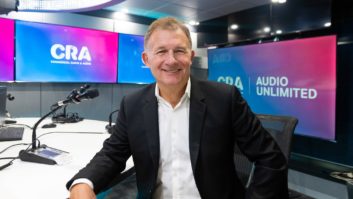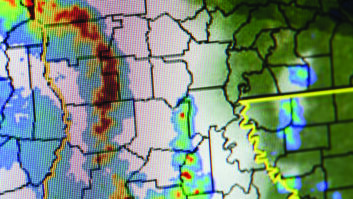
Commissioner Ajit Pai is taking an unusually prominent role, for a commissioner, on the matter of AM revitalization.
credit: © NAB
The question of AM revitalization is on my mind today.
A reader appreciated Chris Imlay’s commentary in the Jan. 16 issue. Imlay, he emailed me, “was right on the mark regarding interference below 30 MHz by the electronic devices out on the market today.”
But, he continued, “all the writing on it seems to fall on deaf ears. Why doesn’t the FCC realize what they have done by allowing so many devices that interfere with services? … It seems the FCC does not care about frequencies below 30 MHz when it comes to interference. Chase a pirate on FM, find a beacon light out on a tower, public files not in order at a station … but interference from a device?”
He continued, “They don’t hear the plasma TV noise, electric machine noises, PC interference, cellphone interference, CFL light bulb interference ,overhead light rail lines interference, etc., etc., etc. interfering with the AM radio.
He concludes: “Surely somebody at the FCC must say, ‘We need to look into this.’”
Well, somebody has.
Let’s hear the options
To be clear, the FCC explicitly acknowledged AM’s issues years ago, writing in its AM translator rulemaking that “the combination of higher-fidelity alternatives to AM radio and increased interference to AM radio have caused an erosion of the AM radio audience and loss of young listeners to other programming outlets.”
Yet frustration about AM’s situation is common in our industry, and the sense of urgency is growing.
You’ll recall that Radio World featured a series of articles about it starting in 2009, with a front-page story titled “Is AM Radio Still Relevant?” That headline startled a lot of people, and some criticized the underlying assumptions; but to me, the need for a broad industry discussion about AM’s situation was obvious. Since that time we have published several commentaries and stories exploring various angles, including the matter of device interference.
AM regulatory options also have been a focus of discussion by the new NAB Radio Technology Committee, reporting to the NAB Radio Board.
These welcome talks unfortunately have taken place out largely of the public eye. Details of the committee’s “AM Engineering Study” — authorized by the radio board in late 2011 — have never been published.
I reported then that committee would look into options involving the technology of content delivery, regulation and frequency band rules; I speculated that it might explore options like moving AMs to frequencies shared with TV; allowing AMs to make more use of translators and FM IBOC multicasts; and taking advantage of less-discussed options like mobile DTV.
My hope is that whatever ideas the committee developed, its ideas will be put forth publicly, so that the industry at large can debate them and benefit. (An NAB spokesman told me recently the report was for the board’s internal use only, and was not intended to be published.)
We know that one idea is to let AM stations turn off their analog and broadcast entirely in digital. As RW has reported, there has been a bit of testing of this, with more anticipated. The National Radio Systems Committee received a briefing on the tests at the recent CES, and we expect to hear more about that project at next month’s NAB Show.
But whether the all-digital path is a practical one is anyone’s guess. My own speculation is that, faced with a menu of improvement options, AM broadcast owners would probably prefer more limited regulatory tweaks first. Yet there hasn’t been sufficient industry debate over what those other options might be.
Regulatory help?
One person pushing the issue is, in fact, quite prominent at the FCC.
Commissioner Ajit Pai wants the FCC to help AM.
“Specifically, we should conduct a comprehensive review of all our AM radio rules,” he said at last fall’s Radio Show. “We should focus on one basic question: Are there regulatory barriers we can remove to help this sector rebound?”
He is well aware of the problems mentioned by our reader above.
“One notable change is that AM reception has gotten worse,” Pai said then. “The causes of interference to AM signals have only expanded in the last two decades. If you’ve tried flipping through the AM dial recently, you know what I’m talking about.”
Pai even acknowledged a “widespread perception that today’s FCC is largely indifferent to the fate of [broadcasters ’] business.”
He is about to take an even more visible role. He will lead a session on this topic at the NAB Show — an unusual, maybe unprecedented, decision for a commissioner. I think it’s a great idea.
According to NAB, “This session, held within the Broadcast Management Conference, will address possible options for sustaining and enhancing AM radio as a unique entertainment medium.”
I hope the session will get specific. I hope Pai will delve into some other improvement options he mentioned in passing last fall, such as a possible across-the-board power increase for AM stations, the use of synchronous AM transmission systems and development of “anti-skywave antennas” so that some stations wouldn’t have to go dark at night.
Regardless, we need to keep up the momentum on this. We live in a world where spectrum is highly sought after; if a critical mass of influence makers were ever to perceive that the senior radio band truly was vulnerable, you could expect someone to make a play for it. Even putting that possibility aside, consider what Ben Downs of Bryan Broadcasting Corp., who sits on the NAB Radio Board, told me in late 2011: “I truly believe if we do nothing, we’ll have no AM band in five to 10 years. We have very little of one now.”
More than a year has passed.
Related:











